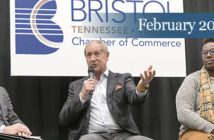Roy L. Harmon, Jr.’s roots in business success stretch much further back than his 1980 initiation into the world of banking. They stretch back even further than involvement with Junior Achievement as a Dobyns-Bennett High School student in the early 1970s. In fact, the son of a Holston Valley nurse and a Mead Paper lab technician says, “I can’t remember a time when I didn’t have a job.
“When I was growing up I was always doing something to earn money,” says Harmon, who has helped Bank of Tennessee’s profitability during more than two decades with the bank, most as CEO.
By the time the Kingsport native took his first “real job” at the age of 12, working weekends as a “starter” at the Meadowview Golf Club, Harmon was a veteran of everything from mowing lawns and raking leaves to picking up Coke bottles and newspaper publishing. That’s right, newspaper publishing.
“I wrote a newspaper for the neighborhood,” recalls Harmon, who grew up with his parents and two sisters in the upstairs of a Valley Street home owned by a widow, Mrs. Kilgore. “People would pay you a nickel for it and you had to hand-write every one.”
Harmon was born July 9, 1954 at Holston Valley Hospital, the hospital where his mother worked. Kubelene Hatmaker Harmon was from West Knoxville and had graduated from Ft. Sanders Hospital’s nursing school. She was working at Holston Valley when she met Roy Harmon Sr., a Harriman native who had come to work at “The Mead” after leaving the Navy.
Roy Harmon’s was a typical working-class Kingsport upbringing. Roy Sr. was the consummate ball coach/father, who spent 25 years coaching the Dobyns-Taylor Babe Ruth team in Kingsport. He stressed fundamentals, effort and commitment and never pretended that everyone is a winner.
“He felt like his goal was to help you become a man. You either won or you lost – you didn’t get a participation trophy,” Harmon says.
While he was very competitive, Harmon says, his dad was also fair. “If you showed up and practiced and put in the effort, you got to play. His famous saying is, ‘Hustle never made up for ability.’”
While Roy Sr. was imparting an understanding of the real world, Kubelene was leading by example – particularly after Roy Sr. became disabled when Roy Jr. was a high school junior. “My mother became the sole provider, because his disability pay was not a lot.”
Finally, there was Mrs. Kilgore, who was always there when Roy arrived home from school – first at nearby Lincoln Elementary, then at Sevier Junior High and Dobyns-Bennett. In addition to teaching young Roy important life skills such as laundry and cooking, Mrs. Kilgore had a couple aphorisms of her own that have stuck with him to this day.
“Once a job is first begun, do not quit until it’s done,” was the first, Harmon says. “Her other saying was, ‘do it right or not at all.’”
By the time he was entering his senior year, Harmon’s work ethic had helped land him a job at Sobel’s men’s clothing store. Norman Sobel tapped a promising rising senior each year to work in the store. “I got the job from Bill Argabrite, and then I passed the job on to Bill Dudney,” Harmon recalls.
By that time, Harmon had also made the acquaintance of a fellow student named Liza Brown. They dated a few times – “we went to her senior prom, but it was no serious romance” – and went their separate ways. Harmon went off to University of Tennessee-Knoxville and wound up graduating with an accounting degree.
Harmon also had determined one thing when he went off to college – he wasn’t coming back to Kingsport to live.
So he landed a job with Arthur Andersen, spending almost five years with the then No. 1 of the Big Eight accounting firms. “There was a lot of responsibility very quickly. You either succeeded or you were gone,” he remembers.
When Harmon left he joined EG&G Ortec, a Boston-headquartered company with an Oak Ridge office. It wasn’t his cup of tea, but he did receive some advice that he cherishes still today from his Ortec boss, Tom Yount.
“His advice was, ‘in order to become successful, look at what successful people are doing and do as much of it as you can.’ He was talking about investments, work, public service. That’s kind of what you’re really after in Junior Achievement is to model yourself after these people that are proven leaders in their various ways.”
After a year with Ortec, Harmon turned down a transfer to Boston. A friend whose bank, Park National, was in a leadership transition, called and asked if he’d like to become CFO.
“I didn’t start out to be a banker,” Harmon says. But there he was, going to work for a community bank in 1980, just before the Jimmy Carter-era interest rates. The bank had a huge portfolio of bonds that didn’t put it in the best position.
“I learned a lot about adversity at that time, and how stressful it is in a banking environment,” Harmon says.
When First American purchased Park National, Harmon stayed on and became interim chief credit officer before moving into the real estate division, and eventually into supervising a small business lending division.
By this time it was 1989 and Harmon had learned that the former Liza Brown had moved with her three young children back to Kingsport from Atlanta after her husband’s death. He drove his red Porsche over to visit her one Sunday afternoon and it became the beginning of something wonderful.
They began dating and by the fall of 1989, Roy Harmon was back in the town to which he had once been determined not to return. He was the happy dad of Emily, Kathleen and John, who were 11, 7 and 4 at the time (today they are a Ph.D. analytical chemist in Boston, an ob/gyn in Raleigh, N.C., and a Ph.D. biomedical engineer at the Mayo Clinic). But as Harmon tells it, “I did not want to work for a large bank in a small market.” So, while he’d found domestic happiness, he was still on the hunt for the right fit in banking.
Between late 1989 and the summer of 1991, he had watched Bank of Tennessee with interest, and thought the then-$100 million concern with a $65 million loan portfolio had potential for organic growth in a market dominated by regional banks.
“I knew that by focusing on service and responsiveness and attention to customers, a nimble organization could really take advantage of the market.”
At the Ridgefields Invitational golf tournament in 1991, Harmon approached Bill Greene, chairman, president and CEO of the Bank of Tennessee and asked if he’d be interested in having a discussion about a job. Greene invited Harmon for an interview, which lasted about three hours. Harmon had done his homework. “I told him of the opportunity I felt like existed for Bank of Tennessee to grow, and I convinced him that I had the opportunity to bring Bank of Tennessee a lot of business.”
Based on the interview and Harmon’s skill set Greene brought him on as a senior lending officer. “So we set about to grow the bank, and boy did we,” Harmon says.
The trajectory from $100 million to $500 million was relatively speedy, as Bank of Tennessee’s leadership team attracted the best talent in the market, stuck to its strategy, and let market forces do the rest. Harmon sums it up this way: “It was a matter of creating a community bank where employees could flourish and we could provide value for our customers.”
The bank was at $625 million before a 2013 merger with Carter County Bank brought it to its current $920 million. 2014 saw a record $10 million profit.
Hiring good people has allowed Harmon adequate time to give back to the community and continue enjoying passions such as cycling, fishing and hiking. He was recently named to the Tennessee Lottery Commission and is excited about the potential Tennessee Promise has to improve the state’s economic standing and the lives of its young people. He’s endowed a scholarship at the University of Tennessee, chaired Kingsport’s public art committee and served on the Board of Mayor and Aldermen, among other public service pursuits. But there’s still plenty left in Roy Harmon’s tank when it comes to banking.
Having completed the merger with Carter County Bank, Harmon says, “We’re poised to successfully go forward. Our goal is to be a $2 billion bank in 10 years, and we were profitable every month through the recession. We’re really set to take advantage of what’s coming down the pike.”
While the growth may or may not include acquisitions, it will occur with the bank remaining headquartered in Kingsport. That’s in the strategic plan.
As Harmon proceeds in his career’s latter years, he says he’s learned a great deal. The hardest quality he’s had to master? “Patience in dealing with people, and allowing them to come to the answer in their own way without jumping in front of them or cutting them off. I’ve learned most things we view as adversity will pass. If you take a measured approach to it and be patient, it’s not as bad as you think.”
Harmon believes his self-perception of a charmed life could also be related to his surrounding himself with optimistic people. “We have a great board at Bank of Tennessee. They expect great things and have an upbeat and powerful attitude. I also have great friends. They all love life.”
Opportunity, Junior Achievement-style, is a big part of what Roy Harmon is all about. “I would describe myself as a capitalist. Our job is to provide products and service that customers will pay for, provide meaningful jobs with fair pay and benefits, be profitable and provide an acceptable return to our shareholders. That’s what capitalism is all about. That’s what Junior Achievement’s all about. Some people go into public service and take different avenues, but no matter what you are doing, you should be the best.”




